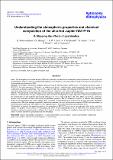Files in this item
Understanding the atmospheric properties and chemical composition of the ultra-hot Jupiter HAT-P-7b II. Mapping the effects of gas kinetics
Item metadata
| dc.contributor.author | Molaverdikhani, K. | |
| dc.contributor.author | Helling, Ch. | |
| dc.contributor.author | Lew, B. W. P. | |
| dc.contributor.author | MacDonald, R. J. | |
| dc.contributor.author | Samra, D. | |
| dc.contributor.author | Iro, N. | |
| dc.contributor.author | Woitke, P. | |
| dc.contributor.author | Parmentier, V. | |
| dc.date.accessioned | 2020-03-25T13:30:02Z | |
| dc.date.available | 2020-03-25T13:30:02Z | |
| dc.date.issued | 2020-03 | |
| dc.identifier | 267051051 | |
| dc.identifier | 1f53d2a9-6a5b-4a24-8c07-9307f78545d1 | |
| dc.identifier | 000519099100001 | |
| dc.identifier | 85088117107 | |
| dc.identifier.citation | Molaverdikhani , K , Helling , C , Lew , B W P , MacDonald , R J , Samra , D , Iro , N , Woitke , P & Parmentier , V 2020 , ' Understanding the atmospheric properties and chemical composition of the ultra-hot Jupiter HAT-P-7b II. Mapping the effects of gas kinetics ' , Astronomy & Astrophysics , vol. 635 , A31 . https://doi.org/10.1051/0004-6361/201937044 | en |
| dc.identifier.issn | 0004-6361 | |
| dc.identifier.uri | https://hdl.handle.net/10023/19707 | |
| dc.description | Funding: Part of this work was supported by the German Deutsche Forschungsgemeinschaft, DFG project number Ts 17/2–1. | en |
| dc.description.abstract | Aims. The atmospheres of ultra-hot Jupiters (UHJs) are commonly considered to be at thermochemical equilibrium. We aim to provide disequilibrium chemistry maps for a global understanding of the chemistry in the atmosphere of HAT-P-7b and assess the importance of disequilibrium chemistry on UHJs. Methods. We applied a hierarchical modeling approach using 97 1D atmospheric profiles from a 3D general circulation model of HAT-P-7b. For each atmospheric 1D profile, we evaluated our kinetic cloud formation model consistently with the local gas-phase composition in chemical equilibrium. This served as input to study the quenching of dominating CHNO-binding molecules. We evaluated quenching results from a zeroth-order approximation in comparison to a kinetic gas-phase approach. Results. We find that the zeroth-order approach of estimating quenching points agrees well with the full gas-kinetic modeling results. However, it underestimates the quenching levels by about one order of magnitude at high temperatures. Chemical disequilibrium has the greatest effect on the nightside and morning abundance of species such as H, H2O, CH4, CO2, HCN, and all CnHm molecules; heavier CnHm molecules are more affected by disequilibrium processes. The CO abundance, however, is affected only marginally. While dayside abundances also notably change, those around the evening terminator of HAT-P-7b are the least affected by disequilibrium processes. The latter finding may partially explain the consistency of observed transmission spectra of UHJs with atmospheres in thermochemical equilibrium. Photochemistry only negligibly affects molecular abundances and quenching levels. Conclusions. In general, the quenching points of the atmosphere of HAT-P-7b are at much lower pressures than in the cooler hot-jupiters. We propose several avenues to determining the effect of disequilibrium processes on UHJs that are in general based on abundance and opacity measurements at different local times. It remains a challenge to completely disentangle this from the chemical effects of clouds and that of a primordial nonsolar abundance. | |
| dc.format.extent | 25 | |
| dc.format.extent | 48429207 | |
| dc.language.iso | eng | |
| dc.relation.ispartof | Astronomy & Astrophysics | en |
| dc.subject | Planets and satellites: atmospheres | en |
| dc.subject | Planets and satellites: gaseous planets | en |
| dc.subject | Planets and satellites: composition | en |
| dc.subject | Planets and satellites: individual: ultra-hot jupiters | en |
| dc.subject | Astrochemistry | en |
| dc.subject | QB Astronomy | en |
| dc.subject | QC Physics | en |
| dc.subject | QD Chemistry | en |
| dc.subject | Astronomy and Astrophysics | en |
| dc.subject | Space and Planetary Science | en |
| dc.subject | T-NDAS | en |
| dc.subject.lcc | QB | en |
| dc.subject.lcc | QC | en |
| dc.subject.lcc | QD | en |
| dc.title | Understanding the atmospheric properties and chemical composition of the ultra-hot Jupiter HAT-P-7b II. Mapping the effects of gas kinetics | en |
| dc.type | Journal article | en |
| dc.contributor.institution | University of St Andrews. St Andrews Centre for Exoplanet Science | en |
| dc.contributor.institution | University of St Andrews. School of Physics and Astronomy | en |
| dc.identifier.doi | https://doi.org/10.1051/0004-6361/201937044 | |
| dc.description.status | Peer reviewed | en |
This item appears in the following Collection(s)
Items in the St Andrews Research Repository are protected by copyright, with all rights reserved, unless otherwise indicated.

